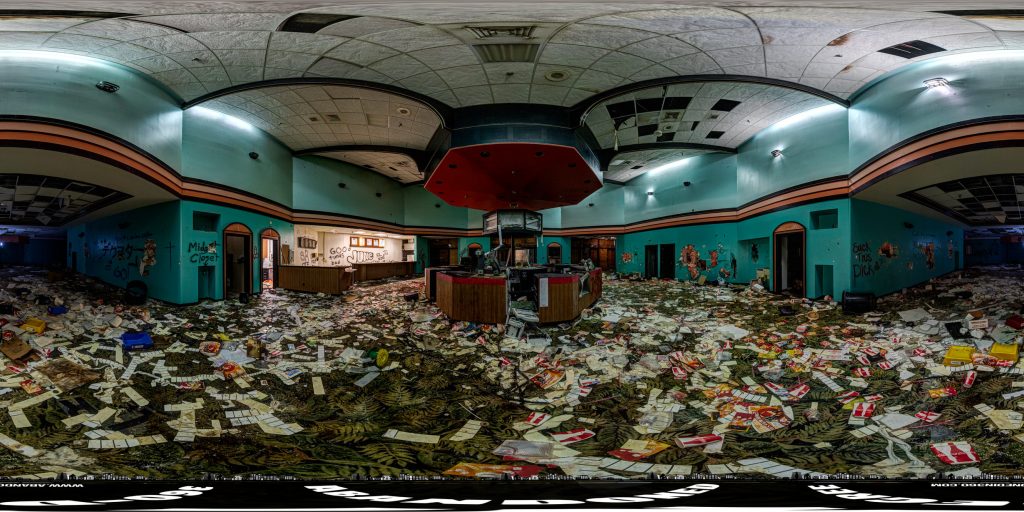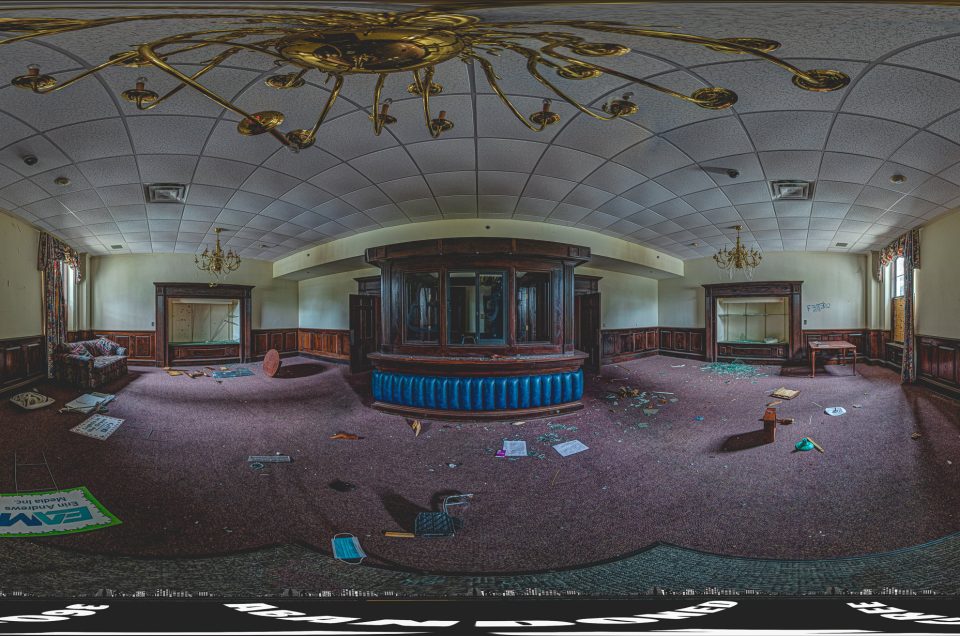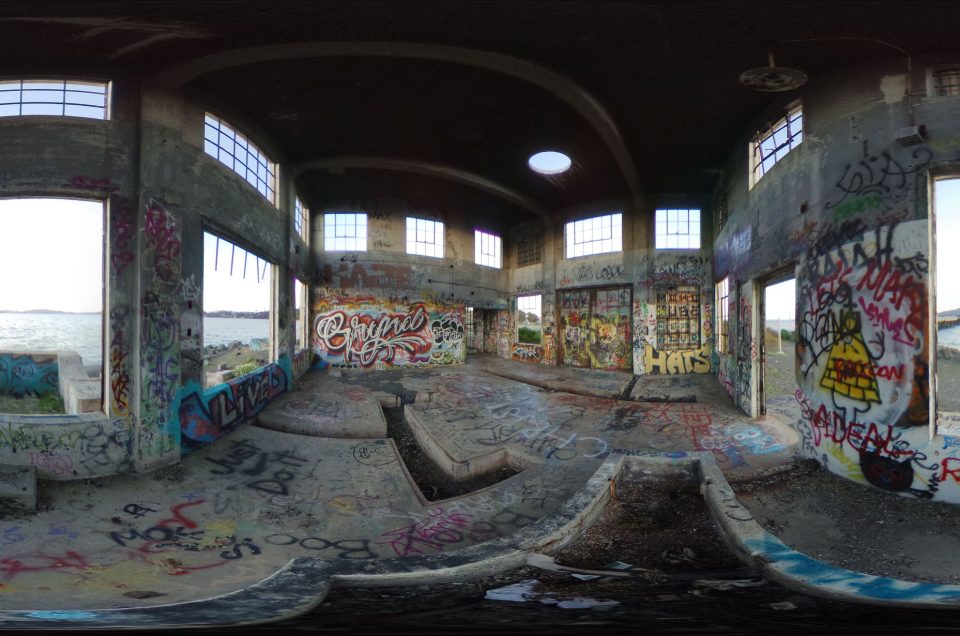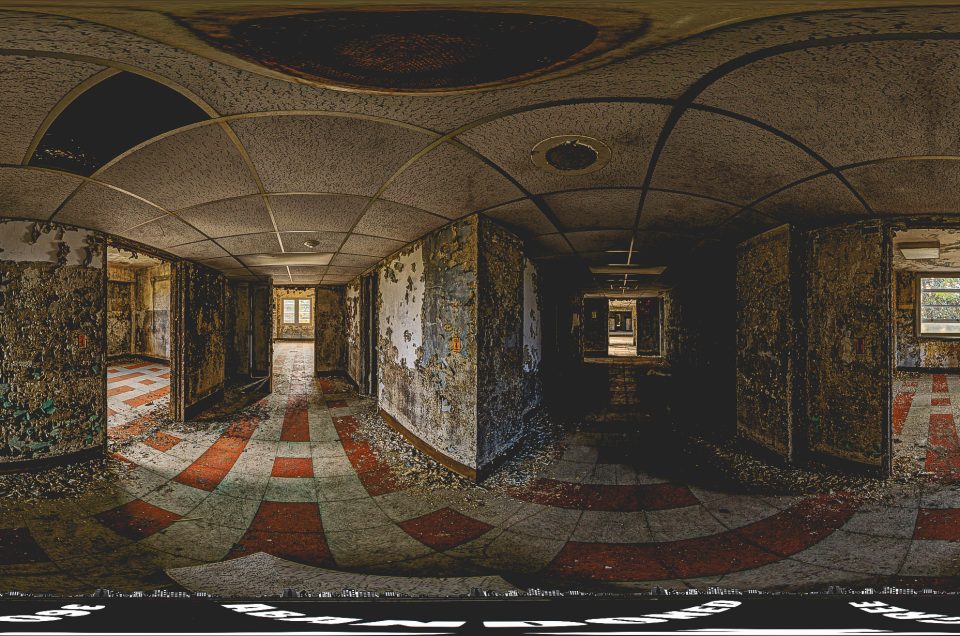Abandoned Roxy Cinema and Grill in Palm Bay, Florida
The Roxy Cinema and Grill in Palm Bay, Florida, holds a unique place in the city’s cultural history. Once a lively spot for locals to enjoy films and dining, it now stands as a quiet reminder of changing times. The structure, though no longer in operation, continues to spark curiosity for those drawn to the stories hidden within abandoned spaces. Its faded walls and empty halls invite explorers to imagine the laughter, conversation, and movie nights that once filled the building.
For urban explorers, the Roxy Cinema and Grill offers more than just an abandoned site—it provides a gateway into the past. With fourteen amazing 360-degree panoramic virtual tour images, you can experience the eerie beauty of its forgotten corners without leaving your home. Each view captures the atmosphere of a place where entertainment thrived, now transformed into a destination for discovery and reflection.
Click here to view it in fullscreen.
In the heart of Palm Bay on Florida’s Space Coast, a once-bustling movie theater now sits eerily silent and forgotten. The Roxy Cinema and Grill – now an abandoned husk of its former self – opened in 1991 as a state-of-the-art multiplex, but today it has become a fascinating time capsule for urban explorers. As one of many theaters abandoned in Florida, the Roxy Cinema and Grill offers a unique glimpse into a bygone era of movie-going and has turned into a magnet for those interested in urban exploring in Florida. This long-closed cinema’s story spans its optimistic opening, a tumultuous operational history, an abrupt closure in 2013, and years of gradual decay. In this blog post, we’ll delve into the Roxy’s history – its opening year, operating years, and activities – and uncover the reasons for its abandonment. We’ll also walk you through what remains inside this forgotten theater and provide useful tips for anyone planning to explore such abandoned sites. Let’s roll the film on the rise and fall of the Roxy Cinema and Grill.
History of the Roxy Cinema and Grill
Opening in 1991 – A Modern Multiplex: The Roxy Cinema and Grill originally opened its doors on June 28, 1991. It was launched by the Cobb Theatres chain as the Cobb Roxy 10 Cinemas, boasting 10 screens to serve the growing communities of Palm Bay and nearby areas. This made it one of three Cobb multiplex theaters opened in southern Brevard County around the late 1980s and early 1990s. At the time, a 10-screen cineplex was a big deal – a modern “megaplex” concept that could show multiple films simultaneously. The Roxy quickly became a popular spot for locals to catch the latest flicks, complete with the era’s distinctive theater decor (neon lights, colorful carpeting, and bold architectural flourishes characteristic of Cobb Theatres). In fact, the building featured some signature design elements of Cobb theaters, such as curvy vintage-style signage and angled corners on the facade. In its early years, the Roxy 10 Cinema was a family-friendly hub for entertainment, and it even included two small restaurant spaces flanking the lobby – a pizzeria (“Mister Tony’s”) on one side and a wings joint on the other – to offer visitors dining options alongside their movie experience.
Ownership Changes and Challenges: The cinema’s journey through the 1990s and 2000s was anything but smooth. In 1997, Cobb Theatres sold the Roxy 10 (along with its sister theaters in the area) to Regal Cinemas, a major national chain. Under Regal’s ownership the theater operated as a typical multiplex for a few more years. However, by the early 2000s, the theater’s fortunes began to wane. Cobb Theatres actually reacquired the location in 2002, but then promptly closed the Roxy – likely due to declining revenues or the need for upgrades. For a time, the cinema sat dark. By 2004, it was operating as a discount “$1 theater” showing second-run movies, when a new challenge struck: the devastating hurricanes of 2004. Palm Bay was hit by a particularly active hurricane season that year, and the Roxy Cinema suffered damage or prolonged power outages, leading it to close during that 2004 hurricane season. After those storms, the theater didn’t reopen for several years, remaining shuttered as a vacant building in a struggling shopping plaza.
Reinvention as a Cinema Grill: In 2007, plans emerged to breathe new life into the old theater. An independent operator (a local businessman named James Duffy) aimed to reopen the venue with a new concept: a “cinema grill” that would combine movies with dining service. The idea was to offer a full dine-in movie experience – something that was gaining popularity at the time. True to the concept, the revamped Roxy featured menus at each seat and offered patrons the ability to order food (like burgers, chicken tenders, even steaks) and have it served during the film. This was in addition to the usual popcorn, candy, and soda at the lobby concession stand – effectively turning the theater into a dinner-and-a-movie venue. The Roxy Cinema Grill opened briefly in 2007 with this format, hoping to capitalize on the novelty of in-theater dining. Unfortunately, the revival was short-lived. Within just a few months, the Roxy Cinema Grill shut down again. The exact reasons for this quick failure aren’t well documented, but it likely came down to financial difficulties, insufficient customer traffic, and the challenges of renovating an older theater. The brief 2007 relaunch left the Roxy once again dark and silent by the end of that year.
Phoenix Theatres Era – A Last Comeback: After the failed 2007 attempt, the Roxy would get one last shot at life. In mid-2009, Phoenix Adlabs Theatres (part of a regional theater chain also known as Phoenix Theatres or Phoenix Big Cinemas) took over the property. Phoenix Theatres officially reopened the Roxy on July 1, 2009, restoring first-run movies to its screens and continuing the cinema grill concept of offering meals during the show. Locals were able to once again buy tickets at the Roxy and enjoy new Hollywood releases, and the theater was rebranded as “Roxy Cinema Grill 10.” Under Phoenix’s management, the Roxy operated for several years in the early 2010s. Patrons could sit in the updated auditoriums with their food orders while the projectors rolled, and the lobby – still rocking a decidedly 1990s aesthetic – was back to bustling with moviegoers. However, this renaissance didn’t last forever. By 2013, trouble was on the horizon for the Roxy Cinema Grill once again, this time from an industry-wide shift that would deal the final blow.
The Final Curtain: Closure in 2013 and Reasons for Abandonment
The Roxy Cinema and Grill’s ultimate closure came in September 2013, and it was precipitated by an unavoidable technological change. Around this time, the film industry was transitioning from 35mm film prints (the traditional reels of film) to digital projection for all new movies. This change required theaters worldwide to invest in expensive digital projection equipment, often costing tens of thousands of dollars per screen. For large cinema chains this conversion was a costly but manageable necessity. For a smaller independent theater like the Roxy, it proved to be an insurmountable hurdle. In late 2013, as studios announced they would stop releasing movies on 35mm film, the owners of Roxy Cinema Grill determined that the cost of converting the location to digital projection would have been too expensive, and chose to shut the theater’s doors rather than undertake the costly upgrade. In other words, the Roxy closed not due to lack of audience or a typical business failure, but because of a technological mandate it couldn’t afford to meet. The theater’s last operator, Phoenix Big Cinemas, officially ceased operations at the Roxy on September 5, 2013. After that final showtime, the projectors (still the old film projectors) went dark and the doors were locked for good.
It was a rather ironic and sad end for the Roxy – a community movie house that had weathered hurricanes and economic ups and downs, only to be felled by the march of progress in cinema technology. The closure also coincided with new competition in the area: just a year later, in 2014, a brand-new Carmike Cinemas (now AMC) multiplex opened only a few miles away in West Melbourne’s Hammock Landing center. That modern theater drew away any remaining market for movies in Palm Bay. Given the twin challenges of expensive technology upgrades and shiny new competitors, it’s easy to see why no new operator stepped in to save the Roxy. After September 2013, the Roxy Cinema and Grill was left to sit vacant. What had once been a lively local hangout was now just another dark, empty building – albeit one with its projectors, seats, and even kitchen equipment all frozen in time inside.
Abandonment and Decay of a Once-Lively Theater
After its 2013 closure, the Roxy Cinema and Grill entered a prolonged period of abandonment. Remarkably, the theater was left almost entirely intact inside when it closed – as if the staff shut the doors one day and never returned. As observed by those who have peeked inside, the Roxy “has hardly been touched since Cobb opened this place in 1991”. The original decor from the early ’90s remains in place throughout the lobby and halls. The bold, curved marquee sign still hangs on the building’s facade, now blank and sun-faded, and the roadside sign by Palm Bay Road even retained some of its changeable letters for years after closing. The fact that this theater sits abandoned in a practically dead shopping center (the Crossroads Plaza, which lost its anchor grocery store and many tenants long ago) only adds to the eerie atmosphere. This is a place truly frozen in time.
Inside, the scene is that of a time capsule movie theater. The lobby is exactly as it was in the early 2000s, complete with teal and pink pastel-colored walls and checkerboard tile accents that scream ’90s nostalgia. The concession stand – branded the “Food Works” – still houses all the usual equipment: popcorn machine, soda fountains, candy display, hot dog rollers, and even the grill and kitchen area for the cinema grill food service. In fact, for a while after closure, the interior lights of the lobby and some signage were curiously left on, casting a faint glow over the unused snack counters and menus. (One visitor wryly wondered “who’s paying the energy bill” for those always-on lights.) In the auditoriums themselves, rows of cushioned seats face blank screens, with projector booths collecting dust above. Some auditoriums had been modified for dining with small tables or widened spacing between rows from the cinema grill conversion. All of it now sits in total silence, illuminated only by whatever sunlight filters through cracks or the lobby windows.
Over the years of abandonment, nature and time have taken their toll on the Roxy. The once-bright paint on the walls has faded and peeled. In some places, water leaks have caused mold (Florida’s humidity is relentless, and a building without climate control for years will inevitably get “moldy,” as many explorers note). The carpeted floors likely hold a musty smell of mildew and stale popcorn oil. Signs of decay and vandalism have also begun to appear. By the mid-2010s, observers noted that the building had badly deteriorated since 2015, with evidence of homeless individuals sheltering there, “weird massive spiderwebs” in corners, and graffiti starting to adorn the walls. All the windows and glass doors were eventually boarded up for security, after vandals broke some of the glass. Trash and debris litter parts of the interior and exterior, testament to years of neglect. The two small restaurant spaces that adjoined the theater (Mister Tony’s Pizzeria and the former Wings-N-Things location) are empty and gutted, aside from a few leftover items like an old pizza oven hood or a bag of frying batter left behind in the kitchen. The once-bright “Mister Tony’s” sign now hangs as a dusty memory on the front of the building, and an outline of the removed Wings-N-Things sign is still visible on the other side.
Outside the theater, the parking lot is cracked and encroached by weeds. The marquee above the entrance reads nothing but blank lines – “Now Showing: Nothing”, as one onlooker quipped. A faded “Roxy Cinema Grill” logo remains on the building, though some letters have fallen off over time. There are also No Trespassing signs posted around the property, put up by the property owners to ward off intruders. Interestingly, one sign noted that police would give a warning to leave before making any arrests, suggesting that authorities were aware of curious explorers poking around the site. The Roxy’s owners have changed hands over the years (currently a private company holds the property), but there have been no serious moves to redevelop or reopen the building as of yet. As of the last update in 2019, and still true today, the Roxy Cinema and Grill remains vacant, slowly decaying behind its boarded-up doors. Its fate is uncertain – some speculate it could be demolished or perhaps repurposed (there was even an idea that it could make a good church, as has happened to other old theaters). But for now, the Roxy stands as a dormant relic of entertainment history.
Urban Exploration of the Roxy Cinema and Grill
For urban explorers, abandoned theaters like the Roxy Cinema and Grill hold a special allure. Peering through the Roxy’s glass doors (or through gaps in the boards), one can glimpse the haunting scene inside – the dim lobby with its concession stand as if ready for customers, the movie posters from a decade ago still hanging in frames, and the arcade area (yes, there was a small game room off the lobby) standing silent with maybe an old change machine left behind. It’s the definition of a “frozen-in-time” location. Explorers who have ventured inside (either legally through permission or by sneaking in unlawfully – which we do not recommend) describe the experience as stepping into a past era. The air is thick with humidity and nostalgia. A flashlight beam will dance across rows of empty seats, perhaps illuminating leftover popcorn buckets or film reels. In the projection booth, one might find the old projectors or film platters, untouched since the last reel was shown in 2013.
However, exploring the Roxy is not without its risks. Being private property, the theater is officially off-limits to the public; those who trespass do so at their own peril. The building is known to be occasionally checked by local police or security, and there are reports of explorers being warned or escorted off the property. (One Reddit user warned that the Roxy “is an oldy and moldy” and to be careful because “you might get arrested” if caught trespassing.) The interiors are also dark and potentially hazardous – broken glass, exposed wiring, and unstable fixtures are all possible. Florida’s wildlife can creep in too; it’s not unheard of for abandoned buildings in this area to house bats, snakes, or at least plenty of insects. Additionally, the evidence of homeless occupancy means one could encounter someone seeking shelter inside, which could lead to unsafe situations.
That said, for those passionate about documenting abandoned places, the Roxy offers a rare and photogenic subject. The contrast of its once-vibrant spaces now layered in dust and dim light makes for striking photography. Explorers have captured images of the marquee sign with missing letters, the empty ticket booths, and the desolate auditorium seats facing a blank screen, all of which tell a somber story of a place that entertained thousands in its prime. The site has even attracted YouTubers and bloggers who document abandoned places in Florida, eager to showcase the Roxy’s crumbling projection rooms and retro lobby design. If you’ve ever wondered what becomes of a movie theater after the final credits roll and everyone goes home, a visit (or a careful external survey) of the Roxy Cinema and Grill will certainly fire the imagination.
Historical Significance: Beyond the exploration thrill, the Roxy stands as an interesting historical footnote in Florida’s cinema landscape. It embodies the life cycle of a neighborhood theater: opened during a boom of multiplexes, struggled through market changes, innovated with a new concept (dinner-and-a-movie) to try to survive, and ultimately succumbed to industry changes. It’s also a local landmark of sorts for Palm Bay – many longtime residents have fond memories of seeing movies there in the ’90s and 2000s, perhaps not realizing their beloved theater would one day sit in ruin. Such sites are reminders of how quickly technology and consumer habits evolve, leaving behind places like the Roxy as modern ruins. The Roxy Cinema and Grill may not be as historically famous as some classic old movie palaces, but for Brevard County it is a piece of communal history. As it decays, it also highlights the issues of urban blight – being located in a dying strip mall, its abandonment contributes to the overall decline of the area, making it a target for vandals and a challenge for the community to address.
Tips for Urban Explorers in Florida
Exploring abandoned sites like the Roxy Cinema and Grill can be an exciting experience, but it must be done safely, responsibly, and legally. Here are some urban exploring tips – particularly relevant to urban exploring in Florida:
-
Obtain Permission if Possible: The safest way to explore is to get permission from the property owner. Given that the Roxy is privately owned, try contacting local real estate authorities or the city to see if there are official opportunities to tour or photograph it. Trespassing laws in Florida are strict, and being caught without permission can lead to arrest. Always weigh whether the risk is worth it.
-
Never Explore Alone: If you do decide to explore an abandoned location, go with a friend. Not only is it safer in case of an accident, but an extra person can help look out for hazards. In places like the Roxy, which are dark and potentially unstable, having a buddy is crucial.
-
Come Prepared with Safety Gear: Florida’s abandoned buildings can be hot, humid, and full of mold or dust. Wear sturdy shoes (broken glass and rusty nails are common on these sites), long pants, and bring gloves. A high-quality flashlight or headlamp is a must for dark theater auditoriums. It’s also wise to wear a respirator or mask to avoid inhaling mold spores or asbestos that might be present in older construction. Insect repellent is useful too – abandoned structures in Florida often become home to mosquitoes, wasps, or other pests.
-
Beware of Environmental Hazards: In addition to mold, be mindful of wildlife. Snakes, bats, rodents, and spiders might be sharing the space. Never reach blindly into dark spaces or under debris. Also, Florida’s climate can make structures deteriorate faster – floors might be soft from water damage and could give way, so test each step and avoid upstairs areas if you suspect they’re weakened.
-
Respect No Trespassing Signs and Law Enforcement: If a site like the Roxy is posted with No Trespassing signs (it is), that’s a clear warning. Some urban explorers choose to proceed anyway, but know that police in Palm Bay are aware of popular spots like this. If confronted, be polite, cooperate, and leave immediately if asked. Arguing can only make things worse. As noted earlier, some officers might give a warning to leave first, but don’t count on leniency.
-
Take Only Pictures, Leave Only Footprints: The golden rule of urban exploration is to leave the place as you found it. Do not vandalize, graffiti, or steal objects from the site. Unfortunately, places like the Roxy have suffered some graffiti and theft of relics over time – true urban explorers should condemn this behavior. Our goal is to document and appreciate, not contribute to the destruction. So, if you’re lucky enough to legally explore inside, be respectful. Even small items left behind (old film reels, signage letters, etc.) are part of the location’s story and should remain there.
-
Plan for Heat and Weather: In Florida, heat and sudden storms are factors to consider. Abandoned buildings won’t have air conditioning, so they can become sweltering inside (especially in summer). Stay hydrated and take breaks if needed. Also, avoid exploring during lightning storms or heavy rain – not only could conditions get more dangerous (slick surfaces, collapsing roof leaks), but getting trapped in a storm isn’t fun.
-
Document Your Visit Discreetly: If you take photos or videos, be mindful about sharing sensitive details (like exact addresses or how to access a site) publicly. Responsible explorers often avoid making it too easy for vandals or inexperienced thrill-seekers to find these places. It’s fine to share the history and imagery, but consider the impact on the location. The Roxy Cinema and Grill’s location is fairly well-known locally, but maintaining a bit of secrecy can protect it from further damage.
By following these tips, you can better ensure that your urban exploration adventures are safe and responsible. Florida has many abandoned gems like the Roxy, from old hotels to shuttered factories, and each comes with its own set of challenges. Always do your homework on a site beforehand, and know the legal and physical risks.
Conclusion
The saga of the Roxy Cinema and Grill in Palm Bay, Florida is a poignant one – a theater that brought joy and entertainment to the community for over two decades, only to become an abandoned landmark slowly succumbing to time. From its grand opening in 1991 as a cutting-edge 10-screen multiplex, through its experiments as a cinema grill and its final showing in 2013, the Roxy’s story reflects the broader changes in how we experience movies and the unforgiving nature of progress. Today, the Roxy stands quiet, a shadow of its former glory, but not forgotten. Urban explorers and locals alike still peer through its doors, imagining the projector flickering to life or the smell of fresh popcorn wafting through the lobby.
While its future remains uncertain, the Roxy Cinema and Grill holds a special place in the lore of abandoned Florida attractions and urban exploration tales. It’s a reminder that every abandoned building was once filled with life – laughing audiences, hardworking staff, the thrill of opening night. Whether the Roxy eventually gets demolished, repurposed, or continues to decay, its story will live on through the photographs, memories, and accounts of those who remember it. For urban explorers, the Roxy will continue to be a captivating “lost” location – a place where the past and present collide in hushed auditoriums and dusty lobbies. In the silence of that empty theater, there’s a story worth hearing – of a beloved local cinema that flickered out, and the ghostly after-image it left behind for us to explore
If you liked this blog post, you might find these abandoned locations interesting as well. The Kenosha Theater in Wisconsin, the Bromberg Dynamit Nobel AG Factory in Poland or the Anything and Everything Store in Florida.

A 360-degree panoramic image captured inside the abandoned Roxy Cinema and Grill. Photograph by the Abandoned in 360 URBEX Team
Welcome to a world of exploration and intrigue at Abandoned in 360, where adventure awaits with our exclusive membership options. Dive into the mysteries of forgotten places with our Gold Membership, offering access to GPS coordinates to thousands of abandoned locations worldwide. For those seeking a deeper immersion, our Platinum Membership goes beyond the map, providing members with exclusive photos and captivating 3D virtual walkthroughs of these remarkable sites. Discover hidden histories and untold stories as we continually expand our map with new locations each month. Embark on your journey today and uncover the secrets of the past like never before. Join us and start exploring with Abandoned in 360.
Equipment used to capture the 360-degree panoramic images:
- Canon DSLR camera
- Canon 8-15mm fisheye
- Manfrotto tripod
- Custom rotating tripod head
Do you have 360-degree panoramic images captured in an abandoned location? Send your images to Abandonedin360@gmail.com. If you choose to go out and do some urban exploring in your town, here are some safety tips before you head out on your Urbex adventure. If you want to start shooting 360-degree panoramic images, you might want to look onto one-click 360-degree action cameras.
Click on a state below and explore the top abandoned places for urban exploring in that state.








